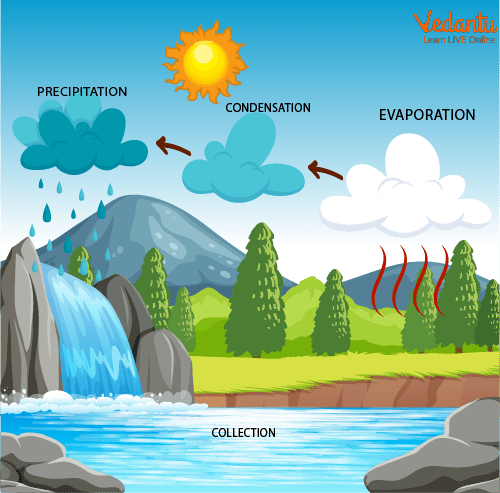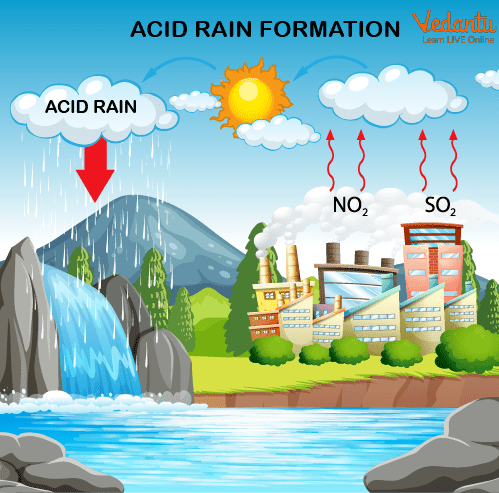




Why Does it Rain? A Brief Introduction About Rain
Rain is good for our environment, as we all know. It keeps everything lush and green, provides us with clean water to drink, and aids farmers in growing food. There are three forms of water. It could be a gas such as water vapour or steam, solid as ice, or liquid. Water falls from the sky as rain, which is water in a liquid state.
Rain fills all of the lakes, ponds, rivers, streams, and wetlands. It provides freshwater that is necessary for people, animals, and plants. But if it rains excessively, dangerous floods could happen. Read through the following sections of the article to know more about this miracle of nature – Rain!
Formation of Rain
The continuous water cycle on the earth involves rain. At the beginning of the cycle, sunlight warms the water on earth's surface. The heat causes the water to evaporate or change into water vapour. Water vapour is pervasive in the air. When it cools, the water vapour returns to droplets of water.
These droplets combine to form clouds in large numbers. Smaller water droplets in a cloud mix to form larger drops of liquid. The drips eventually weigh too much to remain in the cloud. They descend to earth as rain and the water cycle starts over.
In the clouds, water droplets occasionally turn into ice crystals. Sometimes, as the ice crystals fall toward the earth, they melt. This is yet another way of formation of rain.

Water Cycle
What Causes Rainfall?
Since water is always in motion, rain that has recently rained where you live can have been ocean water just a few days ago. Water can be found underground as well as in the ocean, on land, and in the atmosphere. It is used again through a process known as the water cycle. Water transitions between liquid, solid, and gas in this cycle (which is water vapour). The process of evaporation is how water vapour enters the atmosphere.
The water that is on top of seas, rivers, and lakes is subsequently converted into water vapour in the atmosphere utilising energy from the sun. Additionally, snow and ice can emit this vapour. The water vapour rises into the atmosphere, where it condenses into small water droplets after cooling down. Then, clouds are formed from these tiny droplets. They become larger and too heavy to remain in the air when they are all combined together. Due to gravity, they will then start to descend to the ground as rain, snow, or hail, and thus it causes rainfall.
After the rain has stopped, a significant portion of it flows into the oceans, rivers, lakes, and streams that eventually empty into our oceans. Like glaciers and other types of ice, snow and ice remain on the Earth's surface.
Rain Process - Different Forms of Precipitation
Rain process is also known as precipitation. It is the term used to describe water that has fallen from the sky as rain, freezing rain, sleet, snow, or hail.
What are the Effects of Rain?
Almost everything on the earth experiences rain. Mount Waialeale in Hawaii ranks among the rainiest places on earth. There, it rains for roughly 350 days a year. They receive about 460 inches (1,170 centimetres) of rain each year. The Atacama Desert in Chile is one of the driest regions on earth. Less than 0.04 inches (0.1 centimetres) of rain falls there each year. In some areas of this desert, it hasn't rained in hundreds of years.
Dust and filth are removed from the air by rain. However, rain is not always pure. Polluting substances from motor vehicles, factories, and power plants can occasionally get caught in clouds. These dangerous substances are in the rain that comes from these clouds. Acid rain is a term for this contaminated rain that can harm people, animals, plants, and property.

Acid Rain Formation
Summary
Rain is a part of the continuous water cycle on earth. Sunlight warms the water on the surface of the earth at the start of the cycle. The water evaporates or turns into water vapour as a result of the heat. The air is filled with water vapour. The water vapour condenses back into droplets of water when it cools. Condensation is a process that causes droplets to form around dust and other particles.
Numerous of these droplets join together to produce clouds. In a cloud, smaller water droplets combine to generate larger drops of liquid. The drips eventually weigh too much to remain in the cloud. As rain, they fall on the earth. The water cycle then restarts. We hope we have been able to teach you something new about rain today. If you liked reading the article, visit our website for more interesting Science topics.
FAQs on How is Rain Formed? The Process of Rain for Kids
1. How is acid rain formed?
One of the effects of air pollution is acid rain. Sulphur dioxide and a large portion of nitrogen oxides are released by power plants when they burn fossil fuels like coal to create electricity. Additionally, nitrogen oxides and sulphur dioxide are released into the atmosphere by vehicles such as buses, trucks, and cars. These toxins are the root of acid rain. Volcanic eruptions also naturally trigger this process. It happens when water in the atmosphere comes into touch with pollution from companies, vehicles, or heating boilers.
1. How is acid rain formed?
One of the effects of air pollution is acid rain. Sulphur dioxide and a large portion of nitrogen oxides are released by power plants when they burn fossil fuels like coal to create electricity. Additionally, nitrogen oxides and sulphur dioxide are released into the atmosphere by vehicles such as buses, trucks, and cars. These toxins are the root of acid rain. Volcanic eruptions also naturally trigger this process. It happens when water in the atmosphere comes into touch with pollution from companies, vehicles, or heating boilers.
2. What is a water cycle?
When water droplets in a cloud mix, they eventually grow heavy enough to descend to the earth as rain. The water cycle demonstrates how water is constantly moving both inside the earth and in the atmosphere. Water vapour is created when liquid water evaporates, and this water vapour then condenses to form clouds and falls back to earth as rain and snow.
Different stages of water flow through the atmosphere (transportation). Runoff, infiltration, and percolation are three ways that liquid water moves across the land and through the earth (groundwater). Plants absorb groundwater, which then evaporates from the plants and enters the atmosphere (transpiration). Ice and snow that is solid can instantly turn gaseous (sublimation).





















